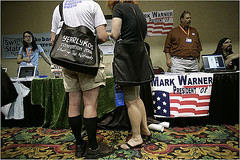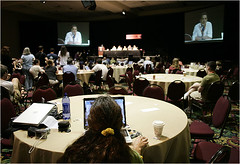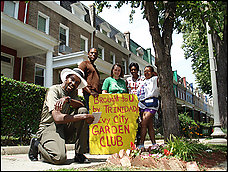Blogs as a tool to focus energies on revitalization
 Rick Scibelli Jr. for The New York Times. Potential presidential candidates, campaign representatives and Washington reporters were in abundance Friday at the YearlyKos 2006 Convention, a three-day gathering of bloggers in Las Vegas.
Rick Scibelli Jr. for The New York Times. Potential presidential candidates, campaign representatives and Washington reporters were in abundance Friday at the YearlyKos 2006 Convention, a three-day gathering of bloggers in Las Vegas.Yesterday's Examiner had an interesting article by Chris Bowers, "YearlyKos and the rise of progressive netroots," on "YearlyKos," a convention of progressive bloggers and followers of a progressive agenda, built on the foundation of the DailyKos blog. From the article:
A new political power is rising in America, and last weekend it had its coming out party. The progressive “netroots,” the 10 million progressive Americans who engage in politics online, held their first major conference, YearlyKos, in Las Vegas from June 8 to 11. Named after the nation’s leading political blog, Dailykos, the conference drew more than 1,000 attendees. Despite limited outside funding and being organized by an all-volunteer staff, the conference was universally praised as well-run. Panels started on time, the wireless network performed well, food was plentiful, and it was easy to see and hear all speakers.
Then again, that the netroots were able to put together a major conference on a shoestring budget and with an all-volunteer staff should not be surprising. Since 2002, the primary media arm of the progressive netroots, the progressive blogosphere, has grown from an audience of about 10,000 to more than 3 million readers a day, despite operating on a budget smaller than that of the daily newspaper you are reading right now.
 Rick Scibelli Jr. for The New York Times. The crowd attracted to the convention demonstrated that blogging has become a way for candidates to organize and communicate with voters
Rick Scibelli Jr. for The New York Times. The crowd attracted to the convention demonstrated that blogging has become a way for candidates to organize and communicate with votersDrawing upon the do-it-yourself values of what Richard Florida has called “the creative class,” the populist outpouring that is the progressive netroots thrives upon the inventiveness, tirelessness and passionate desire for change found among its participants.
(Also see these articles from the New York Times, "Gathering Highlights Power of the Blog," and "A Mixed Bag of First Impressions by Democrats at Blog Rendezvous.")
The same goes for politics and agitation for change at the local level.
Today's Post real estate section has a feature on Trinidad, "Gardened and Glowing in Trinidad," with the subtitle "Residents Turn Their Front-Porch NE Neighborhood Around," focusing on the efforts of a variety of people, including Elise Bernard, a homeowner in the neighborhood (who migrated from a couple blocks south--north of H Street NE), and erstwhile blogmistress of Frozen Tropics (which gets more readership than this blog, and certainly more comments).*
*[although I know why this is so, e.g., this excerpt from an email I received today... "For reasonable reasons I havn't been able to read thru all your site but have seen enough to know you're so right about alot of DC stuff (and I know, of course, with absolute certainty- because I too am always right)"]
 Freddie Stewart, Tony Golden, Elise Bernard, Yamilee Dambreville and Mabel Blocker show a tree box. Ivy City is a next-door neighborhood. (By Marianne Kyriakos For The Washington Post).
Freddie Stewart, Tony Golden, Elise Bernard, Yamilee Dambreville and Mabel Blocker show a tree box. Ivy City is a next-door neighborhood. (By Marianne Kyriakos For The Washington Post).In any case, it speaks to something important, that too often neighborhood organizations or traditional leadership have been, for some time, part of the problem, and that neighbors can come together outside of the traditional neighborhood organizational structure, partly with the assistance of the Internet (note that the Trinidad-Ivy City Garden Club also has its own blog), and work together for change, partly through physical effort, partly through community organizing, partly through perserverance.
I say, many times, with frustration, that part of the problem in our neighborhoods is disinvestment sure, but part of the problem is people and organizations unwilling to move forward, and unwilling to change the way they do things, because those ways of doing things are being proved to be ineffective. Of course, another issue is giving up "power," and that is proving for many to be very difficult.
When it comes to complaints about "gentrification," mostly people are really talking about change and having to accommodate new people, people who may or may not differ in terms of race and/or ethnicity, but do differ in terms of income, educational attainment, lifestyle choices, etc.
Index Keywords: civic-engagement



0 Comments:
Post a Comment
<< Home